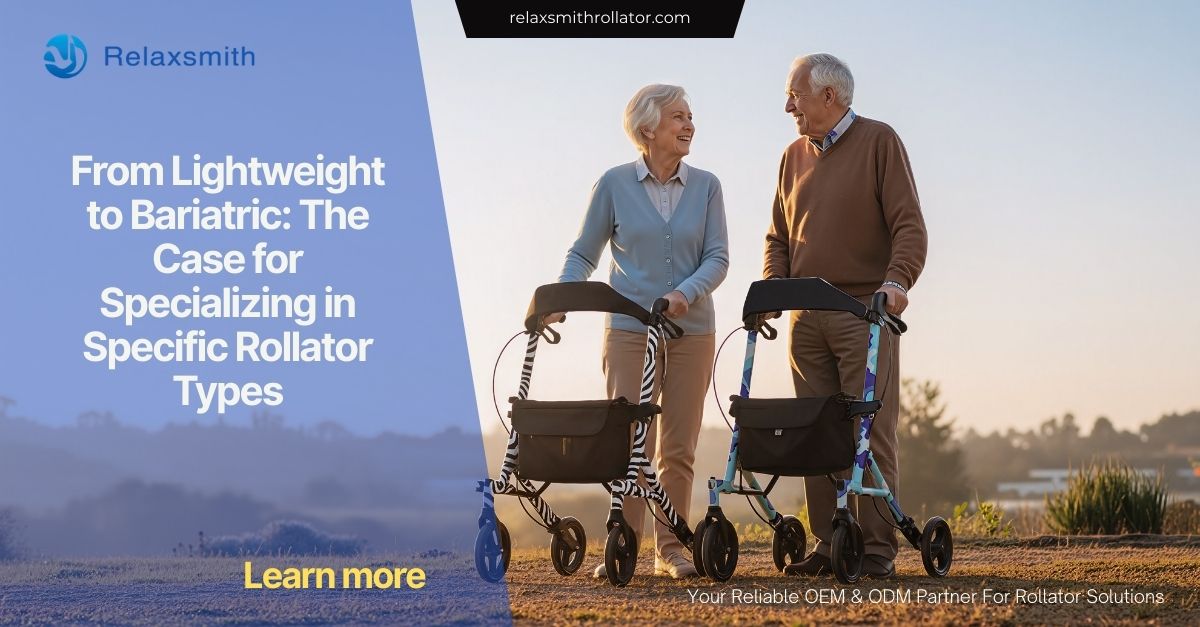From Lightweight to Bariatric: The Case for Specializing in Specific Rollator Types

In rollator design and procurement, weight, capacity, and user environment are key axes. Some brands aim for ultralight portability, others for heavy‑duty support. Understanding why certain manufacturers specialize in certain types of rollators helps you evaluate which brand fits your use case: lightweight travel, standard indoor/outdoor, or bariatric usage. This article explores trade‑offs, materials, design constraints, and procurement implications.
1. Understanding Weight vs Capacity Trade‑Offs
Ultralight rollators prioritize frame weight reduction, smaller wheels, minimal accessories, and compact folding. These enable portability and ease of handling—important in travel, indoor use, or for users with limited strength. On the other hand, bariatric rollators require reinforced frames, larger wheel diameters, wider seats, stronger brakes, and often heavier materials. Brands that specialize in certain types of rollators become adept at managing these opposing demands—lightweight models sacrifice some durability or maximum capacity, while bariatric models may sacrifice portability.
2. Materials & Structural Design Considerations
Choice of materials is one of the most decisive factors. Aluminum alloys reduce weight and resist corrosion, but may flex more under heavy loads unless properly reinforced. Steel or reinforced tubing offers high load capacity and toughness, but increases weight and manufacturing cost. Designs for bariatric rollators also need to carefully consider weld strength, tubing diameter, and joint design. Brands that specialize in certain types of rollators usually invest in material science, tube geometry, and frame reinforcement specific to that type, rather than generalizing across categories.
3. Wheel Size, Brake Design, & Environmental Suitability
Outdoor surfaces, rough terrain, uneven sidewalks all impose stress on wheels, brakes, and wheel housings. Bariatric models often feature large (8‑10 inch or more) wheels with solid or pneumatic tires, powerful brakes (loop or drum), and corrosion‑resistant finishes. Lightweight models may use smaller, simpler wheels and lighter braking systems. A brand’s expertise in a rollator type determines how well these components perform in context—brands that specialize in certain types of rollators better calibrate for these trade‑offs.
4. Testing, Compliance, & Real‑World Durability
Brands focused on bariatric or heavy‑duty models normally subject their products to more severe durability testing: repeated folding cycles, load tests well above typical user weights, corrosion exposure, and component fatigue. Lightweight‑focused brands test for portability, ease of fold/unfold, minimal weight without compromising safety, and ability to support expected user weight reliably. Procurement should check for test reports and certifications specific to the rollator type you need.
5. Procurement & Supply Chain Impacts of Specialization
Specialization affects supply chain: specialized brands may require specific suppliers for strong tubing or large wheels, or custom components which fewer vendors produce. Lead times, cost per component, tooling amortization, and batch quantities vary. For lightweight models, precision welds and lighter alloys may increase cost. For bariatric ones, weight, robustness, and material thickness add cost. Procurement managers need to know these trade‑offs and ensure orders, pricing, and quality match expectations.
6. Conclusion
Whether your priority is transport‑friendly portability or maximum strength, knowing why some brands specialize in certain types of rollators gives you an edge. It helps in setting specifications, evaluating proposals, managing cost, and ensuring user satisfaction. For product managers and procurement teams, aligning rollator type to brand specialization can mitigate risk, reduce returns, and improve long‑term performance.












